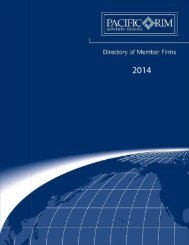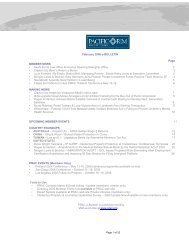A Guide to the Law of Securitisation in Australia - Clayton Utz
A Guide to the Law of Securitisation in Australia - Clayton Utz
A Guide to the Law of Securitisation in Australia - Clayton Utz
- No tags were found...
Create successful ePaper yourself
Turn your PDF publications into a flip-book with our unique Google optimized e-Paper software.
Sections 128AA, 128AC and 128AD conta<strong>in</strong> specific deem<strong>in</strong>gprovisions which can have <strong>the</strong> effect <strong>of</strong> requir<strong>in</strong>g certa<strong>in</strong> amounts<strong>in</strong> connection with discounted securities, <strong>of</strong>fshore hire purchasearrangements and bills <strong>of</strong> exchange be<strong>in</strong>g treated as <strong>in</strong>terest.Def<strong>in</strong>ition <strong>of</strong> debentureA “debenture” <strong>in</strong> relation <strong>to</strong> a company is def<strong>in</strong>ed <strong>in</strong> section 6(1)<strong>to</strong> <strong>in</strong>clude “debentures s<strong>to</strong>ck, bonds, notes and any o<strong>the</strong>rsecurities <strong>of</strong> <strong>the</strong> company, whe<strong>the</strong>r constitut<strong>in</strong>g a charge on <strong>the</strong>assets <strong>of</strong> <strong>the</strong> company or not”. Section 128F(9) specificallyprovides that a debenture <strong>in</strong>cludes a promissory note and a bill <strong>of</strong>exchange.Def<strong>in</strong>ition <strong>of</strong> companyThe exemption <strong>in</strong> section 128F(1) only applies <strong>to</strong> a company. Thisis given an extended mean<strong>in</strong>g <strong>in</strong> section 128F(9) and <strong>in</strong>cludes acompany <strong>in</strong> <strong>the</strong> capacity <strong>of</strong> a trustee <strong>of</strong> a resident trust estate if:“(a) <strong>the</strong> trust is not established by a will, or <strong>in</strong>strument <strong>of</strong> trust,for public charitable purpose; and(b) <strong>the</strong> only person who is capable (whe<strong>the</strong>r by <strong>the</strong> exercise <strong>of</strong> apower <strong>of</strong> appo<strong>in</strong>tment or o<strong>the</strong>rwise) <strong>of</strong> benefit<strong>in</strong>g under <strong>the</strong>trust is a company o<strong>the</strong>r than a company <strong>in</strong> <strong>the</strong> capacity <strong>of</strong>trustee.”The extended def<strong>in</strong>ition permits a securitisation trust (provided itsatisfies <strong>the</strong> requirements <strong>of</strong> paragraphs (a) and (b) above) <strong>to</strong>qualify for <strong>the</strong> exemption from IWT.In circumstances where <strong>the</strong> section 128F(1) def<strong>in</strong>ition <strong>of</strong> acompany is not satisfied, <strong>the</strong> issuer should have regard <strong>to</strong> <strong>the</strong>new section 128FA which extends <strong>the</strong> operation <strong>of</strong> <strong>the</strong> section128F exemption <strong>to</strong> <strong>in</strong>terest payments made by eligible unit trusts.The section 128FA exemption broadly replicates <strong>the</strong> debentureissue conditions <strong>in</strong> section 128F (most importantly, <strong>the</strong> public<strong>of</strong>fer test discussed <strong>in</strong> Part 5.3.3 below).For exemption purposes, an eligible unit trust is be a public unittrust or a unit trust <strong>in</strong> which all <strong>of</strong> <strong>the</strong> issued units are held bytwo or more “eligible unit holders” (i.e. public unit trusts,comply<strong>in</strong>g superannuation funds with 50 or more members, PSTs,comply<strong>in</strong>g ADFs, life companies, public companies or o<strong>the</strong>r unittrusts which satisfy this requirement).5.3.3 The public <strong>of</strong>fer testsThere are six public <strong>of</strong>fer tests. An issuer must satisfy one <strong>of</strong> <strong>the</strong>public <strong>of</strong>fer tests <strong>in</strong> order <strong>to</strong> qualify for <strong>the</strong> section 128Fexemption from IWT.Section 128F(3) sets out five <strong>of</strong> <strong>the</strong> public <strong>of</strong>fer tests. It providesthat an issue <strong>of</strong> a debenture satisfies <strong>the</strong> public <strong>of</strong>fer test if <strong>the</strong>issue results from <strong>the</strong> debenture be<strong>in</strong>g <strong>of</strong>fered for issue:“(a) <strong>to</strong> at least 10 persons, each <strong>of</strong> whom:(i) was carry<strong>in</strong>g on a bus<strong>in</strong>ess <strong>of</strong> provid<strong>in</strong>g f<strong>in</strong>ance, or<strong>in</strong>vest<strong>in</strong>g or deal<strong>in</strong>g <strong>in</strong> securities, <strong>in</strong> <strong>the</strong> course <strong>of</strong>operat<strong>in</strong>g <strong>in</strong> f<strong>in</strong>ancial markets; and(ii) was not known, or suspected by <strong>the</strong> company <strong>to</strong> be anassociate (see subsection (9)) <strong>of</strong> any <strong>of</strong> <strong>the</strong> o<strong>the</strong>r personscovered by this paragraph; or(b) <strong>to</strong> at least 100 persons whom it was reasonable for <strong>the</strong>company <strong>to</strong> have regarded as ei<strong>the</strong>r:(i) hav<strong>in</strong>g acquired debentures <strong>in</strong> <strong>the</strong> past; or(ii) be<strong>in</strong>g likely <strong>to</strong> be <strong>in</strong>terested <strong>in</strong> acquir<strong>in</strong>g debentures; or(c) as a result <strong>of</strong> be<strong>in</strong>g accepted for list<strong>in</strong>g on a s<strong>to</strong>ck exchange,where <strong>the</strong> company had previously entered <strong>in</strong><strong>to</strong> anagreement with a dealer, manager or underwriter, <strong>in</strong> relation<strong>to</strong> <strong>the</strong> placement <strong>of</strong> debentures, requir<strong>in</strong>g <strong>the</strong> company <strong>to</strong>seek such list<strong>in</strong>g; or(d) as a result <strong>of</strong> negotiations be<strong>in</strong>g <strong>in</strong>itiated publicly <strong>in</strong>electronic form, or <strong>in</strong> ano<strong>the</strong>r form, that was used byf<strong>in</strong>ancial markets for deal<strong>in</strong>g <strong>in</strong> debentures; or(e) <strong>to</strong> a dealer, manager or underwriter, <strong>in</strong> relation <strong>to</strong> <strong>the</strong>placement <strong>of</strong> debentures who, under an agreement with <strong>the</strong>company, <strong>of</strong>fered <strong>the</strong> debentures for sale with<strong>in</strong> 30 days <strong>in</strong> away covered by any <strong>of</strong> paragraphs (a) – (d).”Section 128F(4) also provides that <strong>the</strong> issue <strong>of</strong> a debenture by acompany satisfies <strong>the</strong> public <strong>of</strong>fer test if <strong>the</strong> debenture is aglobal bond.Section 128F(10) provides that a debenture is a “global bond” if:“(a) it describes itself as a global bond or a global note;(b) it is issued <strong>to</strong> a clear<strong>in</strong>g house (see subsection (9)) or <strong>to</strong> aperson as trustee or agent for, or o<strong>the</strong>rwise on behalf <strong>of</strong>, oneor more clear<strong>in</strong>g houses; [for this purpose a clear<strong>in</strong>g house isdef<strong>in</strong>ed as a person who operates a facility that is used byf<strong>in</strong>ancial markets for <strong>in</strong>vest<strong>in</strong>g <strong>in</strong> or deal<strong>in</strong>g <strong>in</strong> securities(section 128F(9))]; and(c) <strong>in</strong> connection with <strong>the</strong> issue, <strong>the</strong> clear<strong>in</strong>g house or houses:(i) confer rights <strong>in</strong> relation <strong>to</strong> <strong>the</strong> debenture on o<strong>the</strong>rpersons; and(ii) record <strong>the</strong> existence <strong>of</strong> <strong>the</strong> rights;33






